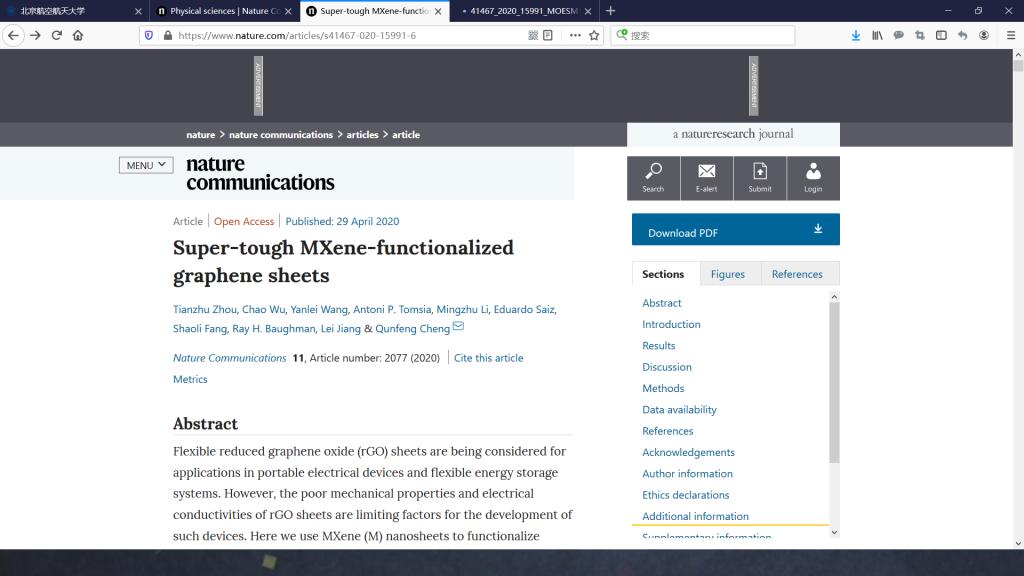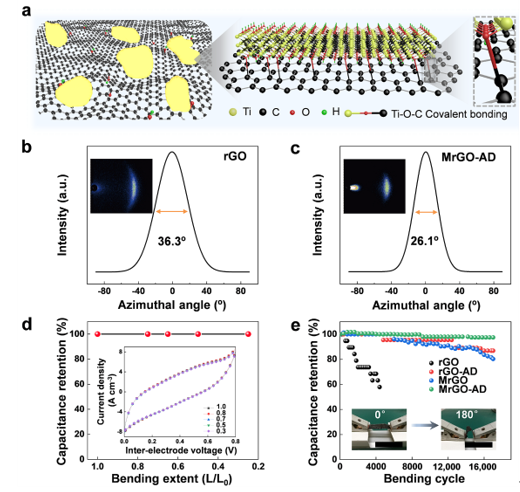On April 29, a reseach team led by Prof. Cheng Qunfeng from the School of Chemistry published their research results titled "Super-tough MXene-functionalized graphene sheets" in Nature Communications. Zhou Tianzhu, a PhD candidate, Prof. Wu Chao and Associate Research Fellow Wang Yanlei are the first authors. Prof. Cheng Qunfeng is the corresponding author.

Recently, MXenes, a new two-dimensional (2D) material and transition metal carbide, has been widely investigated since it was first reported in 2011, due to its high electrical conductivities, large specific surface areas, excellent electrochemical properties, and favorable strengths. However, the application of MXene nanosheets in flexible energy storage system is limited by their poor mechanical properties. For its weak interfacial interactions and low dispersity, traditional blending methods usually lead to the poor mechanical properties of MXene nanosheets. Though the polymer can be compounded with MXene to improve its mechanical properties, the electrical conductivity is difficult to be further improved. A key challenge is to engineer approaches to simultaneously improve the mechanical properties and electrical conductivities of rGO sheets for flexible mobile devices.
The research demonstrates MXene-functionalized and crosslinked graphene oxide (GO) platelets that were obtained through Ti–O-C covalent bonding. Synergistic interfacial interactions involving Ti–O-C covalent bonding and π-π bridging occurred in the MXene-functionalized graphene (MrGO-AD) sheet. The MrGO-AD sheet shows ultrahigh toughness (~42.7 MJ m−3) and a high failure strain of 12.0%. The tensile strength and electrical conductivity were also improved, reaching as high as ~699.1 MPa and ~1329.0 S cm−1. A supercapacitor based on our super-tough MXene-functionalized graphene sheets provides a combination of energy and power densities that are high for flexible supercapacitors.
In situ Raman spectroscopy and molecular dynamics simulations reveal that the super-high toughness of MXene-functionalized graphene sheets attributes to the synergistic interfacial interactions of Ti–O-C covalent bonding and π-π bridging interactions, and the sliding of stacked MXene nanosheets. Furthermore, wide-angle and small-angle X-ray scattering (WAXS and SAXS) show that the orientation of rGO platelets and that the compactness of MrGO-AD sheets is enhanced. Assembled flexible supercapacitors using the MrGO-AD sheet provide a volumetric energy density of ~13.0 mWh cm−3 and outstanding flexibility, with ~98% retention of capacitance after 17,000 bending cycles to 180°. In-series operation of MrGO-Ad supercapacitors can light an LED when in flat, bent or twisted states. Hence, MrGo-AD sheet provides a new research direction for the preparation of two-dimensional composite sheets with both mechanical and electrical properties.

a. Schematic model of MXene-GO platelets showing the formation of Ti–O-C covalent bonding. b-c. Azimuthal scan wide-angle X-ray scattering (WAXS) patterns (for a rotating anode X-ray source) showing the full width at half maximum (FWHM) of rGO (b) and MrGO-AD (c). d. Capacitance retention as a function of the bending extent of the supercapacitor (which is defined as the ratio of the end-to-end separation in the bent supercapacitor to this separation for the non-bent supercapacitor). e. Capacitance retention for supercapacitors based on rGO, rGO-AD, MrGO, and MrGO-AD sheets during up to 17,000 bending cycles to a bending extent of 25% (which corresponds to a 180° angle between supercapacitor ends). Scale bar, 2 cm (inset).
With the guidance of Prof. Jiang Lei, academician of the Chinese Academy of Sciences, this work was cooperated with Prof. Antoni P. Tomsia from Lawrence Berkeley National Laboratory,Researcher Li Mingzhu from the Institute of Chemistry, Chinese Academy of Sciences, Prof. Eduardo Saiz from Imperial College London, and Prof. Fang Shaoli and Prof. Ray H. Baughman from the University of Texas at Dallas. The research was supported by the Excellent Young Scientist Foundation of the National Natural Science Foundation of China (NSFC), the NSFC, Newton Advanced Fellowship, Beijing Natural Science Foundation, the 111 Project, the Thousand Talents Plan, etc.
For more information of the research:
https://www.nature.com/articles/s41467-020-15991-6
Reported by Liu Naipeng
Reviewed by Liu Mingjie
Edited by Jia Aiping
Translated by Zhao Yue

